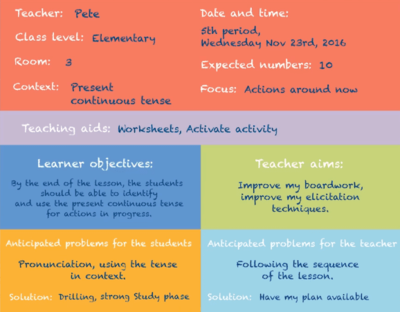Creating a Lesson Strategy That Suits Your Students

A lesson plan can be a valuable tool for a teacher to provide an element of direction and flow for the lesson. A lesson plan can serve as a useful reference during a class and as a record for later use. The writing of the plan itself can also help the teacher to think logically and methodically about the different stages of the lesson and the goals to be achieved.
Table of Contents
Are you ready to take your TEFL course?
This post was written by our TEFL certification graduate Kim B. Please note that this blog post might not necessarily represent the beliefs or opinions of ITTT.
Key Points
Objectives
A lesson plan will generally include the lesson theme and learning objectives, personal aims regarding teaching improvement and any anticipated learning problems, with thoughts on how to deal with them. Thorough planning is important, but a lesson plan is not a script to follow strictly. Some room for flexibility should be allowed in the plan so the teacher can adapt to the needs of the students.

Also Read: Top 10 Qualities Every Great Teacher Should Have
Class Size
When planning a lesson the teacher should consider the class size and the English competency level of the class, making sure the activities are suitable. The activities should be challenging to the students so they do not get bored, but not too difficult such that they become frustrated or are unable to understand the lesson properly. An effective lesson will involve themes that are in line with the student's interests, the teacher should attempt to find out what the student's interests are in advance and take care to include various interests from lesson to lesson to engage all the students.
Timing
Timing is an important factor to consider in the planning stage. You should estimate how much time each activity will take so you can plan the progression of the lesson. This reduces the possibility that you will run out of time for the lesson or that you will have time left over at the end. It is useful to have some extra activities planned for the class in case the students move through the activities quicker than expected. It is better to have too much content rather than not enough and the extra activities can always be carried over to the next class.
Materials
The lesson plan should also include any extra resources required for the class. Music, videos or other objects such as flash cards can be used to keep the lesson interesting and varied. The teacher must consider what props are suitable for the lesson and wherein the lesson they are going to be introduced.

Also Read: 5 Great Ways To Give Your Students Feedback
Teaching Approach
Another factor to include in a lesson plan is what type of interaction is taking place, teacher-student, student-student, or students working alone. Some time with the teacher talking to the class is generally required, but this should be limited as much as possible and balanced with time where the students are interacting with each other. This helps to maximize the time students have to practice speaking English.
Lesson Stages
The Engage, Study, Activate (ESA) method of teaching is an effective method of creating a lesson that will keep the students involved and participating, maximizing their opportunities to practice and develop their English skills. All three of these ESA phases are important to provide a balance of activities for the students and it is useful to write down the phase of each activity on the lesson plan. These phases are outlined in the paragraph below.

Also Read: Should I take a TEFL course online or in a classroom?
Engage and Activate
The 'Engage' phase of a class takes place at the beginning of a lesson, this can involve activities like games, pictures, stories or music. The purpose of this phase is to 'warm up' the students, reducing inhibitions and encouraging participation; the teacher should refrain from correcting the students in this phase as it can be discouraging. This phase is also used to increase the interest level of the students towards the subject of the lesson, all students should be encouraged to speak some English. The 'Study' phase of the lesson is where the students will learn new content and can practice this content in a controlled environment, often involving drilling exercises or worksheets. In this phase the teacher will correct mistakes or assist with problems that the students are having, the focus of this phase is on accuracy. The 'Activate' phase of the lesson is where the students can take the language they have learned and applied it in a free-flowing way with the English they already know, in activities such as role-playing, creative writing or surveys amongst the students. The focus is on fluency not accuracy, the students should be encouraged to be creative and not overcorrected.
Also Read: 7 Great Resources for Teaching Business English
Study
While the lesson will always start with an 'Engage' phase and end with an 'Activate' phase, the middle portion of the lesson can be in multiple formats depending on the complexity of the lesson and the level of the class. Three common types of ESA formats include straight arrow, boomerang, and patchwork; these will be discussed below. A straight arrow lesson is the simplest format, an 'Engage' phase, followed by a 'Study' phase and finally an 'Activate' phase. This format is useful for simple straightforward concepts and generally suitable for a beginner level class. In a boomerang lesson after the first 'Activate' phase a second 'Study' phase takes place and then a second 'Activate' phase at the end, this allows the teacher to asses the needs of the class and applies this in the second 'Study' phase. This type of lesson is more suitable with a higher level class. A patchwork lesson can contain multiple ESA phases in the middle of the lesson in whatever order best suits the content and aims of the lesson, with one 'Engage' phase at the start and one 'Activate' phase at the end. This style has the most flexibility in the lesson and is useful for more complex concepts, it is suitable for a class with a high level of English competency.

Also Read: Top 10 Things To Know When Moving Abroad To Teach English
Are you ready to take your TEFL course?
A well-written lesson plan can be an important step towards a well-controlled lesson, helping the teacher to remain relaxed, positive and focussed. The students will respond to this attitude and be more likely to be engaged in the lesson.
Apply now & get certified to teach english abroad!
Speak with an ITTT advisor today to put together your personal plan for teaching English abroad.
Send us an email or call us toll-free at 1-800-490-0531 to speak with an ITTT advisor today.
Related Articles:
- productive receptive skills receptive skills patchwork ESA
- Teaching ESL & Knowing Your Audience: Young Learners vs. Adults
- The Advantages and Disadvantages of Teaching English to Young Children
- My Experience Taking the 50-hour Teaching English to Young Learners TEFL Course from ITTT
- The 10 Most Common Types of EFL Teaching Jobs



